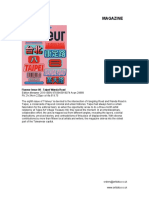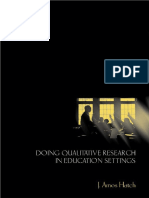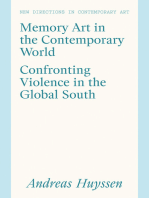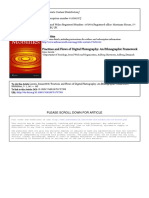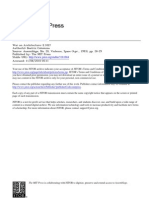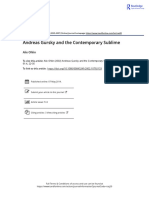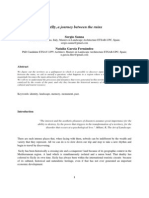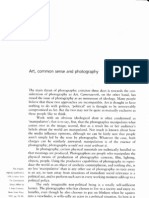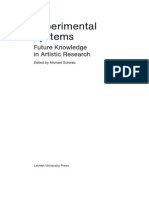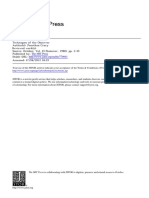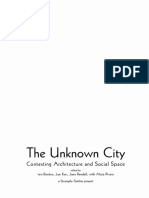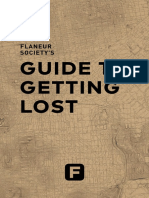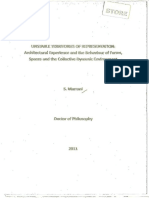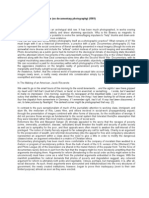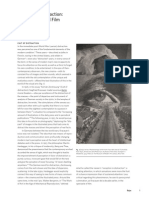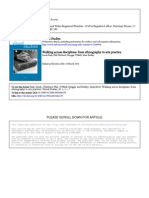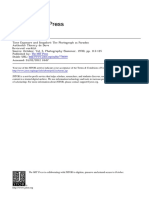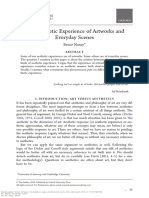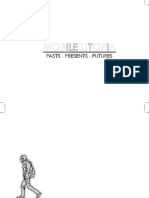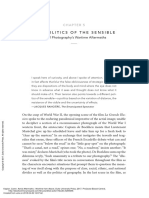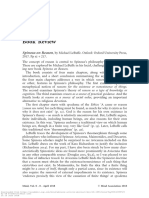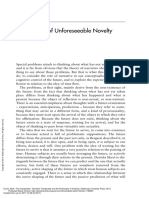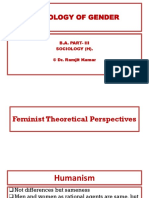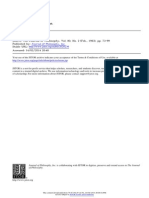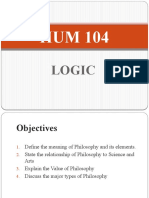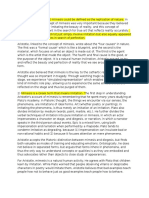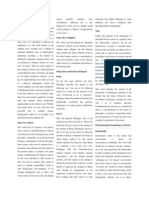Bassett, K, 2004, Walking As An Aesthetic Practice and A Critical Tool, Some Psychogeorgrafic Expe-1
Bassett, K, 2004, Walking As An Aesthetic Practice and A Critical Tool, Some Psychogeorgrafic Expe-1
Uploaded by
Fdo CaCaCopyright:
Available Formats
Bassett, K, 2004, Walking As An Aesthetic Practice and A Critical Tool, Some Psychogeorgrafic Expe-1
Bassett, K, 2004, Walking As An Aesthetic Practice and A Critical Tool, Some Psychogeorgrafic Expe-1
Uploaded by
Fdo CaCaOriginal Title
Copyright
Available Formats
Share this document
Did you find this document useful?
Is this content inappropriate?
Copyright:
Available Formats
Bassett, K, 2004, Walking As An Aesthetic Practice and A Critical Tool, Some Psychogeorgrafic Expe-1
Bassett, K, 2004, Walking As An Aesthetic Practice and A Critical Tool, Some Psychogeorgrafic Expe-1
Uploaded by
Fdo CaCaCopyright:
Available Formats
Journal of Geography in Higher Education, Vol. 28, No.
3, 397410, November 2004
Walking as an Aesthetic Practice and a Critical Tool: Some Psychogeographic Experiments
KEITH BASSETT
School of Geographical Sciences, University of Bristol, UK
ABSTRACT This paper gives an account of a eldwork exercise in Paris which attempted to relate social theory and eldwork practice. The paper begins with a brief historical review of different perspectives on the practice of walking, as a form of movement through the city with aesthetic and critical potential. A more detailed account is then given of the particular theories and practices of the avant-garde group known as the Situationist International, which are drawn upon for the eldwork exercise. The paper then reects on the problems encountered in trying to apply these ideas in a eldwork exercise, and concludes with some comments on improvements and further developments. KEY WORDS: Walking, anerie, Situationists, derive, psychogeography, eldwork Introduction Walking is the best way to explore and exploit the city. (Sinclair, 1997, p. 4). This paper reects on the experience of trying to combine social theory and eldwork in Paris as part of a human geography eldcourse with second-year students from Bristol University. More specically, it focuses on experiments with certain ideas and practices of the avant-garde artistic and political group known as the Situationists who were active in Paris in the 1950s and '60s and whose ideas have recently attracted renewed interest. Their practices included the activity of walking, or `drifting', through the city as a means of exploration and consciousness-raising with subversive intent. However, the Situationist perspective is just one of a line of perspectives that have endowed walking with a deeper meaning and signicance as a critical and aesthetic practice. It is part of the student exercise described here to evaluate Situationist ideas in this wider historical and conceptual framework. Before going to Paris the students will have completed courses in philosophy, and social and spatial theory, which include lectures on theorists such as Lefebvre, Benjamin, de Certeau, Debord, and avant garde movements like the Surrealists and Situationists. Paris is an excellent site for related eldwork because the city
Correspondence address: Keith Bassett, School of Geographical Sciences, University of Bristol, University Road, Clifton Road, Bristol BS8 1SS. Email: k.bassett@bristol.ac.uk 03098265 Print/14661845 Online/04/030397-14 2004 Taylor & Francis Ltd. DOI: 10.1080/0309826042000286965
398
K. Bassett
has not only been the home of many of these theorists but has also functioned as a distinctive source of inspiration and as a test bed for their ideas. The eldwork we get students to do is designed to try and deepen their theoretical understanding of some of these theorists by subjecting their ideas to critical examination under contemporary conditions.
Walking as a Critical and Aesthetic Practice in Theoretical and Historical Perspective Walking, as a fundamental human activity and way of interacting with the environment, has attracted the attentions of poets, essayists, artists, philosophers and social theorists (see Solnit, 2000 for a panoramic survey). A particularly important urban tradition, which I shall briey sketch in, extends from the practices of the nineteenth-century aneur, through the Dadaist `event', the ambulations' of the Surrealists, the urban explorations of Walter Benjamin, the `de `derives' of the Lettrists and the Situationists, the wanderings of the land artists of the 1960s, the experimental practices of groups such as the Italian `Stalkers' in the 1990s, to the recent psychogeographical expeditions of London-based writers such as Ian Sinclair. These different perspectives have involved different practices of walking; different aesthetic, critical and political strategies; and, implicitly, different forms of epistemology and ethnography (Jenks & Neves, 2000). They have also involved shifting visions of the city and changing attitudes towards its spaces (see Careri, 2002 for a stimulating review). The aneur, for example, emerged as a distinctive gure in early nineteenthcentury Paris, portrayed as a disinterested, leisurely observer (invariably male) of the urban scene, taking pleasure in losing himself in the crowd and becoming a secret spectator of the changing spectacle of spaces and places in the city (Ferguson, 1987; Shields, 1987; Tester, 1987). Paris, with its long and rich history, was the ideal city for the aneur. A Parisian street, Walter Benjamin later observed, led the aneur downwards into vanished time, into a past that could prove both spellbinding and intoxicating (Benjamin, 2002, p. 841). But as Benjamin also recognized, the social and spatial context that gave rise to the aneur had already changed by the latter part of the nineteenth century with the Haussmanization of Paris, the rationalization of city planning, and the growth of trafc. The aesthetic and critical impulse behind walking emerged in a new form in the ideas and practices of the Dada movement in Paris in the 1920s. Dada, which originated in Zurich in 1916 and was a reection of a growing disillusionment with Western culture during the First World War, was warmly received by Parisian avant-gardes (Bonnett, 1992; Short, 2001). The Dadaists staged a series of provocative events in theatres and halls around Paris but, as the movement grew stale through repetition of their shock tactics, they tried to extend their activities into the streets by staging outdoor `events'. Such an event famously took place in 1921, when the Dada movement met outside the abandoned church of St Julien-lePauvre, on the Left Bank (Sanouillet, 1965). The event was staged as a kind of mock urban excursion to explore on foot the `banal places' of the city, and ``in particular those places that do not truly have any reason to exist'' (Dada leaet). Although the event was intended to be the rst of a series of excursions to other sites in Paris, this extended plan was never carried through, perhaps because the
Walking as an Aesthetic Practice and a Critical Tool
399
event was not a great success. It rained heavily and the crowd, bemused by the Dadaist antics, soon drifted away (Sanouillet, 1965, p. 245; Breton, 1993, p.53). Dada did not anyway long survive as a Parisian movement. By 1922 its leaders, such as Breton and Aragon, were already moving on to Surrealism. The urban walk retained an important role, but in a new context and with different objectives and meanings. Surrealism ``emphasized the importance of the exploration and liberation of the unconscious through the development of forms of cultural production that privileged spontaneity and chance'' (Bonnett, 1992, p. 74). The city, and Paris in particular, was an important focus of Surrealist activities and experiences (Nadeau, 1989). The city was regarded as the dwelling place of the modern unconscious, an archaeological site of dreams and memories (Foster, 1993, p. 196). Walking the city was a strategic device to give up conscious control, submit to risk and chance, and reveal the unconsciousness zones of urban life. But for this to happen it was necessary to adopt an ``ultrareceptive posture'', to put oneself into ``a state of grace with chance'', so that ``something will happen'' (Breton, 1993, p. 106). A central notion in Surrealist theory was the `uncanny', or the return of the forces repressed in modernism (Fer, 1993). This interest in the uncanny was evident in the Surrealist fascination with the outmoded in all its forms, including outmoded spaces. Hence the classic site of the surrealist walk was the ea market (Foster, 2000, p. 159), where chance discoveries of strange or outmoded objects might precipitate a sense of the uncanny return of historically repressed moments. But the Surrealists also experimented with more organized walks or `deambulations', extending out into the countryside, intended to achieve a state of hypnosis and disorientation, probing the boundaries between waking and dream life (Breton, 1993). The tradition of anerie and Surrealist deambulations was both criticized and carried forward in the later work of Walter Benjamin. Benjamin was critical of the Surrealists, trapped in their individual dreams, and sought instead to awaken city dwellers from what he saw as the collective, consumer dream world of commodity fetishism (Buck-Morss, 1991). His `Arcades Project', which absorbed much of his working life in the 1930s, was intended to provoke this awakening. Benjamin saw the Parisian Arcades, then in a state of decay, as the original temples of commodity capitalism, providing traces of lost fantasies from the prehistory of modernity. To excavate their hidden secrets required three processes, represented in the three gures of the archaeologist, collector and aneur (Frisby, 1986). The archaeologist excavated the past, whilst the collector wrenched objects from their contexts, reconstituting them to reveal their hidden truth through techniques such as montage. The aneur, however, was the one who traversed the city, seeking a way through the labyrinth of the arcades, the city and the masses (Benjamin, 2002). It was also the aneur who provided the images that were the starting point for Benjamin's complex notion of the `dialectical image', when past and present moments ashed into a `constellation', and provided a moment of illumination and awakening from the collective dream (Gilloch, 2002). This brief summary is enough to show how different styles and practices of city walking have been important components of wider aesthetic and philosophical movements. Walking appears as a mode of inquiry, a politics and an aesthetic practice (and often a fusion of all three), and Paris emerges as a critically important site for these experiments. The Situationists were to give these practices a distinctive and radical twist.
400
K. Bassett
The Situationists: Detournement, Derive and Psychogeography The Situationists The Situationist International was formed in 1957 by members of two political and artistic avant-garde movements, the Lettrist International (dominated by Guy Debord) and the Imaginist Bauhaus, which had emerged out of the break-up of the Surrealist movement at the end of the War (Hussey, 2001; Wollen, 1990). The London Psychogeographical Association was also represented (by its one and only member). When the Lettrists merged into the Situationist International in 1957, Debord became the dominant gure in the larger group. The Lettrists and the Situationists published a series of journals and engaged in a wide range of artistic and political activities. Although always a small group, they have had an impact out of all proportion to their numbers. For example, several of their leaders, and many of their ideas and slogans, were inuential in the 1968 uprising, and near revolution, in Paris. The group nally broke up in 1972. Revolution and the Society of the Spectacle The ideas and concepts of most immediate interest to geographers were developed by the Lettrists and Situationists in the period up to 1962, when the focus was on the city as a site for a variety of liberatory practices political, artistic and spatial (McDonough, 1994; Pinder, 2000; Pile, 2002). These practices addressed the question of how the quality of human life could be transformed in what Debord was later to describe as `The Society of the Spectacle', a society increasingly dominated by consumerism and the commodity (Debord, 1967). Modern society, Debord argued, had become a society of capitalist abundance, but a world of free time, leisure and creativity was continually put off by the creation of new wants and new consumer products necessary for the system's survival. Life now presented itself as an immense `accumulation of spectacles', as commodity relations were extended to all areas of life (consumption, leisure, culture etc.). But this system had its own contradictions. It required the continual creation of new wants and desires that could not be satised with commodities that had an ever-decreasing lifespan and quickly became banal. Debord was also scathing about the impacts of modernist planning on cities. A new, modernist architecture and urban planning had divided the city into functional zones, dominated by the automobile and the freeway, and organized space around home consumption and giant shopping malls (or `distribution factories'). Workers had been brought together in `sprawling isolation' in the new suburbs. The Society of the Spectacle, emerging in Paris and other cities, thus represented the ``impoverishment and negation of real life'' (Debord, 1967, p. 215), whilst what was ``really lived''individual experience of daily life remained without language or concepts. But it was this everyday life that must now provide the ground of revolutionary theory and practice, rather than the factory or the artist's canvas. Situationism and the City: Detournement, Derive and Psychogeographie How then to confront the society of the spectacle? How to penetrate its
Walking as an Aesthetic Practice and a Critical Tool
401
all-encompassing ideology and explode its false consciousness? In this context the Lettrists and Situationists were convinced that ``the only legitimate tactics of revolutionary criticism are therefore those which heighten awareness, raising the desire for autonomous action, self-realisation, and subjective expression denied by commodity relations'' (Plant, 1992, p.86). To this end they sought to develop a series of innovative, urban-based practices that resisted being accommodated into the society of the spectacle. A key tactic was detournement (`diversion', or `subversion'). This implied a turning around and reclamation of lost meaning by plagiarizing materials already part of the spectacle and using them subversively against it. In `A user's guide to detournement', Debord and Wolman (1956) gave examples of tournement in prose, lm and architecture (such as re-creating entire de neighbourhoods in a deliberately disorienting way). A related tactic involved the construction of `situations', or events, which liberated the tendency towards play in everyday life. Situations were constructed moments ``of rupture, of acceleration, revolutions in individual everyday life'' (Situationist International, 1958). Another central notion was that of the derive (or `drift'), conceived as ``a technique of rapid passage through varied ambiences'', involving ``playful-constructive behaviour and awareness of psychogeographical effects'' (Debord, 1958). On a derive one should abandon oneself to ``the attractions of the terrain and the encounters (one) nds there''. Although partly indebted to earlier Surrealist experiments in space, the Situationists were critical of the Surrealists' reliance on chance and the pursuit of the strange and uncanny for its own sake. Chance was less important in Situationist practice because cities have ``psychogeographical contours, with constant currents, xed points and vortexes that strongly discourage entry into or exit from certain zones'' (Debord, 1958). The derive was thus to be more than just strolling; it was a combination of chance and planning, an `organized spontaneity', designed to reveal some deeper reality to the city and urban life. The derive was also distinguished from anerie or mere voyeurism by its more critical attitude towards the hegemonic scope of modernity. On a derive one tried to shed class and other allegiances and cultivate a sense of marginality. Derives thus tended to avoid the more obvious tourist areas, which pandered to crass appetites for ultravisible urban spectacles. One could derive alone, but Debord thought small groups were preferable. A derive could last for a few hours, a day, several days, or even longer. The spatial eld might be precisely delimited or vague ``depending on whether the goal is to study a terrain or to emotionally disorient oneself'' by moving to unfamiliar terrain. The spatial eld might be a whole city, a neighbourhood or even a single building. One could explore a xed spatial eld, or if the aim was deliberate disorientation (or a `rational disordering of the senses') rather than exploration, one might start from a `possible rendezvous' (selected by someone who might not turn up), engage complete strangers in conversation, and incorporate various `transgressions' (Debord gives some typically semiserious examples, such as slipping into houses undergoing demolition, hitchhiking through Paris in a transport strike without destination to add to the confusion, wandering in spaces forbidden to the public etc.). The derive is thus a kind of elaborate game, but one that leads to a radical re-
402
K. Bassett
reading of the city. It reected a kind of guerrilla mentality in which the Situationists saw themselves launching raiding parties on the power of the spectacle from bases in the less sanitized parts of Paris (and later London and Amsterdam). On a derive the Situationists typically avoided tourist and petitbourgeois areas, and favoured the ghettos and slums of the urban poor, areas which they romantically saw as assets to the city rather than spaces to be removed by urban planning. The experiences of the derive were also intended to contribute to the construction of a `psychogeography' of the modern city. Psychogeography was ``regarded as a sort of therapy, a fetishisation of those parts of the city that could still rescue drifters from the clutches of functionalism, exciting the senses and the body'' (Sadler, 1999, p. 80). It was induced by places that generated ``salutary states of awe, melancholy, joy or terror'' (Bernstein in Hussey, 2001, p. 91). In Debord's words: ``The sudden change of ambiance in a street within the space of a few metres; the evident division of a city into a few zones of distinct psychic atmospheres; the path of least resistance which is automatically followed in aimless strolls (and which has no relation to the physical contour of the ground); the appealing or repelling character of certain placesall this seems to be neglected'' (Debord, 1958). Psychogeography demanded new forms of cartography, capable of representing states of consciousness and feeling. The Situationists thus sought to map out unites d'ambience, or singular places with special qualities. This unity might reect the social composition of an area, or common architectural style. But the emphasis was placed more on the `soft' mutable elements of urban scenes, such as the play of presence and absence, of light and sound, of rhythms of human activity in time and space, and the association of memories and places. As well as unites d'ambience, the Situationists identied nodes or pivotal points (plaques tournantes), which acted like turntables as one progressed through the city. They referred to pentes (gradients) in urban space, resistant and non-resistant `paths' through the ssures of the urban network, `axes` and `passages', boundaries and `lines of defence'. Some sense of what they were searching for can be found in Khatib's `An attempt at a psychogeographical description of Les Halles' (Khatib, 1958). From walking and observation through the old market area (now demolished and rebuilt), Khatib tried to identify the boundaries of the quarter, its internal unites d'ambience, its pivotal points, its ssures and lines of resistance, its sudden breaks, its bastions and defences (of the bourgeois quarters, for example). In another example Debord and Jorn constructed their `Naked City' map of Paris, by cutting up and rearranging parts of street maps to form a psychogeographic map, with psychic units, plaques tournantes, pentes etc. Arrows represented tendencies to drain along non-resistant paths; and the distances between areas represented `effective distances' rather than physical distances between places (Pinder, 1996).
The Psychogeographic Tradition These urban-focused practices were particularly important in the early phase of Lettrist and Situationist activity. After about 1962 they became less important as
Walking as an Aesthetic Practice and a Critical Tool
403
political goals and strategies shifted, and in 1972 the Situationist International was wound up entirely (Hussey, 2001). However, many of its ideas owed on through various artistic, architectural and political movements in various European countries, including Britain (for architecture, see Sadler, 1999; Borden and McCreery, 2001; Swyngedouw, 2002, and for impacts on Punk and popular culture, Marcus, 1989). Psychogeographical practices also survived as an intermittent, almost underground tradition, to re-emerge with new vigour in recent years. A search for psychogeographical websites reveals the existence of various groups based in European and US cities. The `Social Fiction' group's website, for example, recounts recent experiments with `algorithmic and non-algorithmic' derives in rives different Rome and Holland (Social Fiction, 2002). For algorithmic de groups followed a simple algorithm (second right, second right, rst left, repeated) to construct a path through the city, sometimes resulting in zigzag paths, sometimes spirals and loops. Their diaries record events, sensations, comments etc. at random points. In the UK the psychogeographic tradition is also evident in the work of Ian Sinclair. In Lights Out for the Territory he recounts a series of walks through salubrious and insalubrious parts of London, producing accounts that exude a nervous energy and provide a rich brew of observations, feelings and anecdotes (Sinclair, 1997). Critical reaction to his work has also brought important issues of gender to the surface once more. Scalaway (2001, 2002), for example, argues that Sinclair's `aneur-construct' is characterized by its ``invariable masculinity, by his alienation from the scenes he observes, by his essential solitude''. He `yomps', `cruises', `marches', or `hustles' through the crowds. The city thus appears as something feminine, passively there for the taking, a wilderness-like space of adventure to be conquered or possessed. Scalway tries to develop an alternative notion of ``the exploring strategies for the drifter in a feminine mode''. In contrast with Sinclair's assertive walking she talks of having to look for spaces to slip through and round, of weaving and threading paths, of dodging and darting through urban space. Her ideal is to nd a way of being in the city `as a citizen', and of nding a way of walking which is also more about negotiation and regard for the Other than Sinclair's approach. Practising Psychogeography Different theories and practices of walking, and the Situationist and psychogeographic approaches in particular, provide a rich source of ideas for exploring, experiencing and, it is hoped, understanding cities. In lectures in Bristol we explore these texts and ideas in some detail, situating them in their wider philosophical, political and artistic traditions, and relating them to their historical and spatial contexts. However, translating these ideas into eldwork practices for students poses many interesting challenges. The key principle here is that students are fully involved in the process of critically examining alternatives and working up practical possibilities themselves. Inevitably, any project work will be something of a compromise with Situationist principles, which were, after all, linked to forms of radical transgression preguring the ultimate overthrow of capitalism. We reassure
404
K. Bassett
students that though they might wish to make this their lifetime's project, the overthrow of capitalism is not a course requirement. However, even in an inevitably `de-radicalized' form, Situationist ideas have much to offer and can form the basis for rewarding exercises in urban exploration and understanding that open up a whole swathe of broader questions and issues. I give a brief and critical account of my own experiences on two recent eld trips to Paris in 2002 and 2003. Developing the Exercise The exercises emerged out of a series of iterations following lectures and set readings. Students were encouraged to put forward their own ideas in class, and we worked these up into suggested guidelines, which then became the basis for further discussions and revisions. The end result was a exible framework for group work that left room for groups to experiment in their own ways. The groups themselves comprised 56 students, with one student designated as the group's coordinator, although the actual dynamics of group working was left up to each group to decide. Each group leader was given a pack of material for her/his groups several weeks before leaving Bristol, which included maps, key articles and chapters, and guidance notes. Each group was given an area of central Paris to work in, with boundaries marked on detailed street maps. They were given a tape recorder and brought their own cameras. The areas, selected by me, were large enough and varied enough to provide plenty of scope for a one-day exploration. The areas included a zone centring on Les Halles (partly on the grounds that this had been the site of a Situationist derive before its redevelopment); a zone in Montparnasse extending south of the Montparnasse tower; an area centred on the Place d'Italie which included Paris's Chinatown and the historic Butte aux Cailles; and two multi-ethnic, semi-gentried areas in eastern Paris, one extending east of the Bastille and the other centring on Menilmontant. These were for the most part areas that were away from the more familiar tourist sites and were also areas that most students knew little or nothing about before the visit. Each group was given the task of exploring the psychogeography of its area using a variety of different approaches in combinations that the group members could decide for themselves. They could explore their areas through an algorithmic or non-algorithmic derive, or perhaps switch from one approach to another in the course of the day to see what difference it made. They could take their whole area as a territory to explore through an extended derive, or after an initial period of exploration they could switch to a more intense focus on a smaller sub-area or even building. However they proceeded they had to decide on ways of recording their progress and responses, periodically stopping and recording group or individual discussions, decisions, impressions, feelings, attitudes etc. using notebooks, journals and/or tape recorders. They were urged to experiment with the Situationist vocabulary of unites d'ambiences, plaques tournantes, pentes, passages, axes, borders and defences, paths of attraction and repulsion etc., perhaps extending them with suggestions of their own. They were asked to think about ways of representing the hard and soft phenomena of the city (feelings, senses of calm or dislocation,
Walking as an Aesthetic Practice and a Critical Tool
405
attractions and repulsions etc) in cartographic form, perhaps using Debord's `Naked City' map of Paris as a model of how to represent psychic unities, distances and slopes. In identifying psychogeographic phenomena they were asked to consider not only written or speech recordings, but also sound recordings and photographs to capture the sense of place, thus generating a visual and aural record of their progress as a kind of `walkscape' (Careri, 2001). It was suggested they might also capture meanings and sensations of place through their associations with certain `found objects' such as postcards, artefacts etc., which they could collect during their progress. They were also urged to stop and contemplate what was happening around them during the course of the day, noting how activities, sounds and sensations varied, transforming the sense of place through diurnal rhythms. They were also asked to consider the possible gender dimensions of what they were doing and how they were doing it (each group was made up of male and female students). Did gender make a difference in choosing their routes, and in attitudes and responses to places, paths etc? Could they build this into their understanding of the city and the way they responded to different places? At the end of the day each group returned to the hotel and after a debrieng and discussion session with me each group then had the rest of the evening to order and assemble the members' notes and materials while events were still fresh in their minds. On both occasions I have run this exercise I found that all the groups seemed to have at least enjoyed their day, discovered parts of Paris they had never visited, collected a fund of experiences (some funny, some revealing, and someat least to the eld trip organizersalarming), and engaged in vigorous arguments and debates with each other (which continued on into the evening). In the initial debriengs, however, in spite of acknowledging the pleasures of exploring Paris on foot in spring sunshine, not all members of each group were equally convinced of the deeper value of the exercise. Attitudes were partly affected by group dynamics and membership. Although I did not engineer the composition of each group in too ne a detail, I did try and get a balance of abilities, enthusiasms and personalities. On each occasion, however, I was often pleasantly surprised by the way that groups that looked stronger on paper were often outclassed by groups where my expectations were initially lower. Performance seemed to be affected (strongly in some cases) by the choice of group coordinator. Some proved particularly dynamic and innovative, and their enthusiasm communicated itself to the whole group. In some cases, however, internal disagreements resulted in the marginalization of the leader or internal fragmentation of the group. Attitudes to the exercise were also affected by the kinds of areas that the groups were sent to. Some groups returned enthusiastic about the richness and variety of the areas they explored, whilst others were somewhat dismayed by an apparent seeming homogeneity of landscape they could not seem to differentiate. However, more detailed critical reections on what they had done took place in a more relaxed setting after returning to Bristol.
The Presentation and Follow-up The rst session of the related Space and Spatiality course in the summer term was
406
K. Bassett
Figure 1. Pschyogeography of the Bastille
dedicated to presentations by each group in turn. Each was given 20 minutes to present and comment on its experiences and critically reect on the whole exercise. The groups were encouraged to combine visual material (maps, sketches, photographs, objects) with tape-recordings and other material, as a visual/sound narrative or collage. They were urged to think of imaginative ways of communicating their experiences and ndings to the other groups. The presentations on each occasion varied in quality, but were never less than entertaining, and some were highly imaginative, critical and insightful. Groups used photographs, collages, edited tape-recordings of their discussions, street noises etc. Baguettes and posters appeared as props in re-staged performances of group encounters that caught some of the surrealistic and faintly self-mocking style of Situationism. Other groups preferred to rely on more formal PowerPoint demonstrations. Some groups attempted their own versions of psychogeographic maps in the style of Debord's `Naked City'. Figure 1 shows an example from the Bastille area, showing unites d'ambience, lines of least resistance, plaques tournantes etc., with illustrative photographs. Over the two years the groups have experimented with both algorithmic and non-algorithmic derives. Some have used different combinations during the course of the day, noting the different kinds of paths and experiences they produced. One group had tried blindfolding a leader and using sound and sense of smell as guidance in choosing pathways to try and break away from what they saw as `the tyranny of the visual' in inviting or repelling the choice of paths (see Urry, 2000 on non-visual clues in the city). Another group had
Walking as an Aesthetic Practice and a Critical Tool
407
tried using a dice to choose directions, had changed leaders randomly, or engaged in protracted discussions about psychogeographical prompts in the landscape before arriving at collective decisions. Each approach seemed to produce different results in terms of pathways and the experiences they generated. In the process of carrying out the exercise different groups became more aware of various contrasts, which they variously characterized in terms of differences between Haussmanized boulevards and backstreets, public versus private spaces, the local versus the cosmopolitan, the ordered and the disordered, the light and the shaded, the threatening and the unthreatening etc. They had also become more aware of various lines of attraction and repulsion in the landscapes, and some reported a sense of alienation in various spaces, for example the sense of alienation felt in penetrating public buildings beyond their front spaces, or exploring ambiguous spaces that were not clearly public or private (public housing blocks, hospitals, mairies etc.). Some reported an increased awareness of boundaries and contested spaces. Children's play areas were experienced as spaces of safety and innocence and temporary refuges, but parks could be both welcoming and threatening, often within small distances. One group commented on the nature of `layered spaces' which seem to have contested or multiple meanings, not easy to disentangle. Several groups also questioned whether these kinds of distinctions actually arose `naturally' through their own experiences, or were in a sense `imposed' as a result of prior reading or theoretical knowledge as geographers. Most groups also commented critically on the dominance of `the tourist gaze' in focusing their attention on striking buildings or monuments (Urry, 1990, 2000). Some tried to escape the lure of obvious tourist attractions and paths by trying to follow paths of most rather than least resistance. In discussing routeways and sharing experiences of place most of the groups also became more conscious of gender differences. Some commented on the evident gendering of spatio-temporal rhythms, and became more conscious of the kinds of visual and other clues that made different streets more or less threatening to women. There were also tentative comments about the way the `otherness' of ethnicity subtly, and sometimes not so subtly, inuenced their choices and pathways. Several groups commented on the difculties of navigating what they felt to be bland and mundane spaces on the one hand, and spaces that generated a profusion of surface experiences on the other, both of which induced a kind of dazed withdrawal or distraction, which they realized was the most common state in which we unthinkingly negotiate the city. One group found itself retracing its steps and raised the issue of whether one could derive in the same area several times, producing different experiences as a result. The group noted that retracing a morning's route in the afternoon produced different responses that were partly due to a growing familiarity with an area and partly due to looking out for something different to respond to and record. Finally, various students drew critical attention to the limitations of some of their experiments. One group commented that some of their explorations (e.g. into the `public spaces of housing blocks') turned out to be `sterile detournements' that produced little of value. Several groups raised the problem that a group of students wandering the streets stood out like a sore thumb in some areas, attracting the attention of passers by and locals, who became
408
K. Bassett
suspicious. Some derives were interrupted by temporary `lines of ight' to new starting points.
Some General and Critical Comments In spite of some obvious limitations concerning the time available and safety precautions, there are rewards to be drawn from such an exercise at a variety of levels. First, the exercise involves students in an active and self-critical way in translating theoretical ideas into practical strategies on the ground, and then using their experiences to criticize and comment on those ideas. Linking the eld exercises to textual sources within a wider course structure is important here. Second, such an exercise is a way of getting students to open their eyes and ears to what is often taken for granted or ignored in negotiating urban space. It is a way of raising consciousness of urban places and rhythms, of how we experience both the hard and soft phenomena of the city; of how we can open ourselves up to a wider range of experiences of the city; and how we can record and communicate those experiences. Such an exercise can thus raise issues both about how we read the city, and also how we can write and represent the city. The presentations thus encourage students to experiment with combinations of writing, performance, visual and sound montages, etc. Third, such an exercise is a way of opening up important issues concerning epistemology and methodology. For example, to what extent is a practice like the derive a form of urban ethnography, and how does it compare with or complement other ethnographic techniques? Jenks and Neves (2000) draw some interesting parallels between the aneur and the urban ethnographer in ways which bring out the both the strengths and limitations of anerie and derive. Fourth, and more specically, such an exercise leads to a timely re-examination of Situationist ideas and practices. For example, to what extent does the Situationist vocabularly of pentes, plaques tournantes etc. provide a useful set of conceptual tools for cognitive mapping? An obvious point of comparison here is with the work of Kevin Lynch, who also produced cognitive mapping terminology but from within a totally different tradition of modernist town planning. Compared with Lynch, the Situationist approach is much more subversive and transgressive in its intent. An interesting question to pursue further is what differences this makes to the kinds of cognitive and psychogeographic maps that could be produced in the same city or neighbourhood. A more general question that students also have to confront is the extent to which it is possible to retain the radical intent of Situationism in today's urban and political context. After all, concepts such as derive and detournement were not just intended as tools for spatial exploration and mapping, but were part of a wider strategy to subvert the dominance of the spectacle and open oneself up to potentially liberating and transformative experiences. Can one use Situationist tools for an academic exercise in this kind of way without effectively deradicalizing them to the extent that they become lifeless and un-illuminating? Are the kinds of liberatory and transformative experiences the Situationists were looking for still possible in a more advanced stage of consumer capitalism and changed urban context? Has the original notion of the derive lost much of its critical potential by being incorporated into the very system of urban spectacles it was intended to subvert? After all, the tourist industry itself, through brochures,
Walking as an Aesthetic Practice and a Critical Tool
409
lms and guides, now creates and markets entire districts and quarters within cities as places with distinct ambiences to be consumed as spectacles. Tourist guides of increasing detail, catering to different tastes and interests, provide tourists with networks of pathways to wander through different areas. Some multi-volume guides to Paris steer the interested tourist almost from house to house, providing dense historical detail and instructions on where to direct the gaze. It is almost as if the society of the spectacle has `detourned' the Situationists' tournement. One is then led to ask, what new forms of own attempts at de detournement might now be possible to subvert the society of the spectacle? What form might `situations' take in contemporary urban society? Although no clear answers to these questions have emerged, getting students to debate them has proved reward enough for all concerned. Finally, the engagement with Situationist ideas and practices encourages students to explore further the fascinating artistic and intellectual tradition that I sketched at the beginning, extending from the nineteenth-century aneur, through Baudelaire, the Surrealists, and Walter Benjamin, to the current psychogeographic writings of Ian Sinclair. There are many opportunities for cross-comparison between authors. For example, another of our exercises involves students in attempting to rework aspects of Benjamin's `Arcades Project' (Benjamin, 2002), and in discussion aspects of his urban methodologies can be counterpoised to Situationist ones. Comparisons of Debord's Parisian derives and Sinclair's London aneries also open up questions concerning the way similar techniques might produce radically different results in different cities.
References
Benjamin, W. (2002) The Arcades Project, trans. H. Eiland & K. McLaughlin (Cambridge, MA: Harvard University Press). Bonnett, A. (1992) Art, ideology, and everday space: subversive tendencies from Dada to postmodernism, Environment and Planning D: Society and Space, 10, pp. 6986. Borden, I. & McCreery, S. (Eds) (2001) New Babylonians (Chichester: Wiley-Academy). Breton, A. (1993) Conversations: The Autobiography of Surrealism (New York: Paragon). Buck-Morss, S. (1991) The Dialectics of Seeing: Walter Benjamin and the Arcades Project (Cambridge, MA: MIT Press). Careri, F. (2002) Walkscapes: Walking as an Aesthetic Practice (Barcelona: Gustavo Gili). Debord, G. (1958) Theory of the derive, Internationale Situationniste, 2. Available at: www.bopsecrets.org/SI/index.htm (accessed June 2003). Debord, G. (1987) The Society of the Spectacle (New York: Rebel Press). Debord, G. & Wolman, G. (1956) A user's guide to detournement, Les Levres Nues, 8. Available at: www.bopsecrets.org/SI/index.htm (accessed June 2003). Fer, B. (1993) Surrealism, myth and psychoanalysis, in: B. Fer, D. Batchelor & P. Wood (Eds) Realism, Rationalism, Surrealism: Art Between the Wars, pp. 171247 (New Haven: Yale University Press). Ferguson, P. (1987) The aneur on and off the streets of Paris, in: K. Tester (Ed.) The Flaneur, pp. 2241 (London: Routledge). Foster, H. (1993) Compulsive Beauty (Cambridge, MA: MIT Press). Frisby, D. (1986) Fragments of Modernity (Cambridge, MA: MIT Press). Gilloch, G. (2002) Walter Benjamin (Oxford: Polity Press). Hussey, A. (2001) The Game of War: The Life and Death of Guy Debord (London: Jonathon Cape). Jenks, C. (1995) Watching your step: the history and practice of the aneur, in: C. Jenks (Ed.) Visual Culture, pp. 142160 (London: Routledge).
410
K. Bassett
Jenks, C. & Neves, T. (2000) A walk on the wild side: urban ethnography meets the aneur, Cultural Values, 4(1), pp. 117. Khatib, A. (1958) Attempt at a psychogeographical description of Les Halles, Internationale Situationniste, 2. Available at www.bopsecrets.org/SI/index.htm (accessed June 2003) Marcus, S. (1989) Lipstick Traces: A Secret History of the Twentieth Century (London: Secker & Warburg). McDonough, T. (1994) Situationist space, October, 67, pp. 5977. Nadeau, M. (1989) The History of Surrealism (Cambridge, MA: Harvard University Press). Pinder, D. (1996) Subverting cartography: the situationists and maps of the city, Environment and Planning A, 28, pp. 405427. Pinder, D. (2000) Old Paris is no more: geographies of spectacle and anti-spectacle, Antipode, 32, pp. 357386. Plant, S. (1992) The Most Radical Gesture: The Situationist International in a Postmodern Age (London: Routledge). Sadler, S. (1999) The Situationist City (London: MIT Press). Sanouillet, M. (1965) Dada a Paris (Paris: Jean-Jaques Pauvert). Scalaway, H. (2001) The contemporary aneuse: exploring strategies for the drifter in a feminine mode, Journal of Psychogeography and Urban Research, 1(1) (online journal no longer available). Scalaway, H. (2002) The territorialism of Ian Sinclair, Journal of Psychogeography and Urban Research, 1(2) (online journal no longer available). Shields, R. (1987) Fancy footwork: Walter Benjamin's notes on anerie, in: K. Tester (Ed.) The Flaneur, pp. 6179 (London: Routledge). Short, R. (2001) Zurich Dada as read by Andre Breton, in: S. Foster & E. Peterson (Eds) Paris Dada: The Barbarians Storm the Gates, pp. 95132 (Detroit: G.K. Hall). Sinclair, I. (1997) Lights Out for the Territory (London: Granta Books). Social Fiction (2002) Algorithmic psychogeography. Available at www.socialction.org/ psychogeography/algoeng.htm (accessed June 2003). Solnit, R. (2000) Wanderlust: A History of Walking (New York: Viking). Situationist International (1958) Preliminary problems in constructing a situation, Internationale Situationniste, 1. Available at www.bopsecrets.org/SI/index.htm (accessed June 2003). Swyngedouw, E. (2002) The strange respectability of the Situationist City in the Society of the Spectacle, International Journal of Urban and Regional Research, 26(1), pp. 153165. Tester, K. (1987) Introduction, in: K. Tester (Ed.) The Flaneur, pp. 121 (London: Routledge). Urry, J. (1990) The Tourist Gaze (London, Sage). Urry, J. (2000) City life and the senses, in: G. Bridge & S. Watson (Eds) A Companion to the City, pp. 388397 (Oxford: Blackwell). Wollen, P. (1990) The art and politics of the Situationist International, in: E. Sussman (Ed.) On the Passage of a Few People Through a Rather Brief Moment in Time: The Situationist International, 19571972, pp. 2061 (Cambridge, MA: MIT Press).
You might also like
- Flaneur 8Document1 pageFlaneur 8ArtdataNo ratings yet
- The Provincialism Problem: Then and NowDocument27 pagesThe Provincialism Problem: Then and Nowstillife100% (1)
- Pub Doing Qualitative Research in Education SettingsDocument312 pagesPub Doing Qualitative Research in Education SettingsJim Kastellanos100% (4)
- Crim 4 Professional Conduct and Ethical StandardDocument34 pagesCrim 4 Professional Conduct and Ethical StandardEmelie Tipay93% (14)
- Cartographic PerspectivesDocument84 pagesCartographic PerspectivesnordurljosNo ratings yet
- John McDowell, 'Having The World in View - Sellars, Kant, and Intentionality - Lecture I - Sellars On Perceptual Experience'Document21 pagesJohn McDowell, 'Having The World in View - Sellars, Kant, and Intentionality - Lecture I - Sellars On Perceptual Experience'bkane1100% (1)
- Jeff Wall-Marks of IndifferenceDocument13 pagesJeff Wall-Marks of IndifferenceSomboon Skooisariyaporn100% (1)
- Consumer Culture and Modernity: by Don Slater (Polity Press, 1997)Document6 pagesConsumer Culture and Modernity: by Don Slater (Polity Press, 1997)rizkiikyuNo ratings yet
- Arte Di Frontiera (L'Art Des Frontières)Document16 pagesArte Di Frontiera (L'Art Des Frontières)Christian OmodeoNo ratings yet
- Flows of Digital PhotographyDocument21 pagesFlows of Digital PhotographyAmako SudekiNo ratings yet
- On The Theory of Knowledge, Theory of ProgressDocument17 pagesOn The Theory of Knowledge, Theory of ProgressIsabel Cadenas Cañón100% (1)
- Anthropology, Photography PDFDocument14 pagesAnthropology, Photography PDFIgnacio Fernández De MataNo ratings yet
- Moholy-Nagy, L. (1925) Painting, Photography, FilmDocument41 pagesMoholy-Nagy, L. (1925) Painting, Photography, FilmAndrei NakrulNo ratings yet
- Jacobs (2006) - Photography and The Image of The Empty CityDocument13 pagesJacobs (2006) - Photography and The Image of The Empty CityLauraNo ratings yet
- Photographies: A Life More PhotographicDocument21 pagesPhotographies: A Life More PhotographicVinit GuptaNo ratings yet
- Unitary Urbanism at The End of The 1950s: UnattributedDocument3 pagesUnitary Urbanism at The End of The 1950s: UnattributedrdelsogNo ratings yet
- War On Architecture E.1027 Colomina AssemblageDocument3 pagesWar On Architecture E.1027 Colomina AssemblageJaq PenwellNo ratings yet
- Andreas Gursky and The Contemporary Sublime PDFDocument15 pagesAndreas Gursky and The Contemporary Sublime PDFJavier Basualdo C.No ratings yet
- Wacquant - Following B. Into The FieldDocument28 pagesWacquant - Following B. Into The FieldGonzalo MillanNo ratings yet
- Artistic Collaboration in The Twentieth CenturyDocument25 pagesArtistic Collaboration in The Twentieth CenturyAlexandre PajeúNo ratings yet
- Sicily, A Journey Between The Ruins: Sergio SannaDocument10 pagesSicily, A Journey Between The Ruins: Sergio SannaIrina NemteanuNo ratings yet
- Art, Common Sense and Photography - Victor BurginDocument10 pagesArt, Common Sense and Photography - Victor BurginOlgu Kundakçı100% (1)
- Experimentalsystems SchwabDocument14 pagesExperimentalsystems SchwabmeniqueNo ratings yet
- An Undisciplined Form of Knowledge - Anselm Franke - Mousse MagazineDocument10 pagesAn Undisciplined Form of Knowledge - Anselm Franke - Mousse MagazineValério AraújoNo ratings yet
- Crary, Jonathan - Techniques of The Observer PDFDocument34 pagesCrary, Jonathan - Techniques of The Observer PDFAli AydinNo ratings yet
- Hybrid Walking As Art Approaches and ArtDocument8 pagesHybrid Walking As Art Approaches and ArtAlok MandalNo ratings yet
- The Unknown CityDocument4 pagesThe Unknown CityHasan Basri KartalNo ratings yet
- Falling Into The Digital Divide: Encounters With The Work of Hito Steyerl by Daniel RourkeDocument5 pagesFalling Into The Digital Divide: Encounters With The Work of Hito Steyerl by Daniel RourkeDaniel RourkeNo ratings yet
- Guide To Lost-Flaneur GuideDocument19 pagesGuide To Lost-Flaneur GuideLeOn Wzz 众No ratings yet
- Casey E. - Boundary, Place, and Event in The Spatiality of History PDFDocument7 pagesCasey E. - Boundary, Place, and Event in The Spatiality of History PDFAndreeaNo ratings yet
- Murrani S - 2011 Interdisciplinary Archi ExperienceDocument428 pagesMurrani S - 2011 Interdisciplinary Archi ExperienceCamille CruzNo ratings yet
- Compound HistoriesDocument401 pagesCompound HistoriesdragNo ratings yet
- ROSLER in Around AfterthoughtsDocument13 pagesROSLER in Around AfterthoughtsElisa FerrariNo ratings yet
- Barthes' A.B.C.Document7 pagesBarthes' A.B.C.Anthony ReadNo ratings yet
- On Art's Romance With Design - Alex ColesDocument8 pagesOn Art's Romance With Design - Alex ColesJohn Balbino100% (2)
- Quentin Bajac - Age of DistractionDocument12 pagesQuentin Bajac - Age of DistractionAlexandra G AlexNo ratings yet
- The Radicant: Ilse Van RijnDocument3 pagesThe Radicant: Ilse Van RijnCaroline OzórioNo ratings yet
- Daniel Birnbaum When Attitude Becomes Form Daniel Birnbaum On Harald SzeemannDocument4 pagesDaniel Birnbaum When Attitude Becomes Form Daniel Birnbaum On Harald SzeemannyonhosagoNo ratings yet
- Ghost Story by de Bruyn, EricDocument14 pagesGhost Story by de Bruyn, EricmayapranaNo ratings yet
- Benjamin Buchloh - Allegorical Procedures: Appropriation and Montage in Contemporary ArtDocument15 pagesBenjamin Buchloh - Allegorical Procedures: Appropriation and Montage in Contemporary ArttigerpyjamasNo ratings yet
- Macbeth On Reflexivity 2001Document34 pagesMacbeth On Reflexivity 2001Florencia MoradoNo ratings yet
- Fred. Barthes's PunctumDocument37 pagesFred. Barthes's PunctumClarita ZANo ratings yet
- Dynamic of The Metropolis The City Film and The Spaces of ModernityDocument373 pagesDynamic of The Metropolis The City Film and The Spaces of ModernityFermín Eloy Acosta100% (1)
- White, Michelle - Networked Bodies and Extended Corporealities - Theorizing The Relationship Between The Body, Embodiment, and Contemporary New MediaDocument23 pagesWhite, Michelle - Networked Bodies and Extended Corporealities - Theorizing The Relationship Between The Body, Embodiment, and Contemporary New MediaCaitlinNo ratings yet
- Walking Across Disciplines From Ethnography To Arts PracticeDocument8 pagesWalking Across Disciplines From Ethnography To Arts PracticeJuan ManuelNo ratings yet
- Intersection of Photography and Architecture IntroductionDocument7 pagesIntersection of Photography and Architecture IntroductionPArul GauTam100% (1)
- PreviewDocument59 pagesPreviewIago FernándezNo ratings yet
- On Landscape in Narrative CinemaDocument18 pagesOn Landscape in Narrative CinemaVinit GuptaNo ratings yet
- Thierry de Duve - The Photograph As Paradox PDFDocument14 pagesThierry de Duve - The Photograph As Paradox PDFAde EvaristoNo ratings yet
- The Aesthetic ExperienceDocument12 pagesThe Aesthetic ExperienceA.S.WNo ratings yet
- Nicholas Bourriaud - PostproductionDocument45 pagesNicholas Bourriaud - PostproductionElla Lewis-WilliamsNo ratings yet
- Gerhard Richter's Negatives (October)Document13 pagesGerhard Richter's Negatives (October)CafeRoyalNo ratings yet
- Bourriaud On Ranciere PDFDocument7 pagesBourriaud On Ranciere PDFIleana Ramírez Romero100% (1)
- Photography and Its Role in MemoryDocument8 pagesPhotography and Its Role in MemorymanyaNo ratings yet
- VVAA-Mobile Utopia - Pasts Presents FuturesDocument152 pagesVVAA-Mobile Utopia - Pasts Presents FuturesMaria Julia CorderoNo ratings yet
- Hans Ulrich Obrist - Surface PDFDocument29 pagesHans Ulrich Obrist - Surface PDFMaykson CardosoNo ratings yet
- BirnbaumDocument9 pagesBirnbaumJamieNo ratings yet
- Situationist CityDocument11 pagesSituationist Cityeclairalexander100% (1)
- Kaplan Chap5 Aerial Aftermaths Wartime From Above - (PG 211 - 237)Document27 pagesKaplan Chap5 Aerial Aftermaths Wartime From Above - (PG 211 - 237)lamiabaNo ratings yet
- Spinoza On Reason (Review)Document10 pagesSpinoza On Reason (Review)JNo ratings yet
- The Unexpected Narrative Temporality and The Philo... - (Chapter 1 A Flow of Unforeseeable Novelty)Document23 pagesThe Unexpected Narrative Temporality and The Philo... - (Chapter 1 A Flow of Unforeseeable Novelty)Kehkashan KhalidNo ratings yet
- Intro Argumentation DebateDocument18 pagesIntro Argumentation DebateBritinee Larumbe ArguidoNo ratings yet
- Social Science Essay 2Document4 pagesSocial Science Essay 2D'Arcy FineNo ratings yet
- Liberation TheologyDocument12 pagesLiberation TheologyMalik Atta100% (1)
- ExpalanationDocument6 pagesExpalanationLyslie WP DaytoNo ratings yet
- Interrelation of Meaning of The Word, Concept and ReferenDocument5 pagesInterrelation of Meaning of The Word, Concept and ReferenAnna TarasovaNo ratings yet
- Gender TheoryDocument32 pagesGender TheoryRamjit KumarNo ratings yet
- Devitt Dummett's Antirealism PDFDocument28 pagesDevitt Dummett's Antirealism PDFJohn Christmann100% (1)
- Deleuze DictionaryDocument9 pagesDeleuze DictionaryIulia DelceaNo ratings yet
- Introduction To Political Philosophy-Aristotle (1965)Document163 pagesIntroduction To Political Philosophy-Aristotle (1965)melindaNo ratings yet
- Iain Hamilton Grant - Philosophies of Nature After SchellingDocument245 pagesIain Hamilton Grant - Philosophies of Nature After Schellingcfranciscoo01100% (5)
- Frederik Depoortere - ART - Christ in Postmodern Philosophy - Vattimo, Girard and ZizekDocument3 pagesFrederik Depoortere - ART - Christ in Postmodern Philosophy - Vattimo, Girard and ZizekLuis Leon EstradaNo ratings yet
- Jacques Salvan - To Be and Not To Be - An Analysis of Jean-Paul Sartre's Ontology-Wayne State University Press (1962)Document197 pagesJacques Salvan - To Be and Not To Be - An Analysis of Jean-Paul Sartre's Ontology-Wayne State University Press (1962)Leonardo GranaNo ratings yet
- Lit 7 WK 5 NotesDocument4 pagesLit 7 WK 5 NotesEllie MontalbanNo ratings yet
- Bergson and PhenomenologyDocument5 pagesBergson and PhenomenologyAntonie de ManNo ratings yet
- Remembering (Short-Term) Memory. Oscillations of An Epistemic ThingDocument38 pagesRemembering (Short-Term) Memory. Oscillations of An Epistemic ThingItzcoatl Torres AlcantaraNo ratings yet
- Chatterjee 1999 - Anderson's Utopia PDFDocument8 pagesChatterjee 1999 - Anderson's Utopia PDFDimitris CosmidisNo ratings yet
- Cultural Capital Pierre BourdieuDocument3 pagesCultural Capital Pierre BourdieuKayse Nashe100% (1)
- Hum 104Document10 pagesHum 104Rachel AustriaNo ratings yet
- Does Moore Succeed in Refuting IdealismDocument5 pagesDoes Moore Succeed in Refuting IdealismharryNo ratings yet
- Historical MaterialismDocument23 pagesHistorical MaterialismJade Connoly67% (3)
- Why Decoloniality in The 21st Century-2013Document3 pagesWhy Decoloniality in The 21st Century-2013Wendel DamascenoNo ratings yet
- Memisis of AristotleDocument2 pagesMemisis of AristotleHamayun Khan100% (1)
- 3 Stages of Life by Soren KeirkegaardDocument2 pages3 Stages of Life by Soren KeirkegaardRose AnnNo ratings yet
- Analysing Political DiscourseDocument9 pagesAnalysing Political DiscourseRogers Tabe Orock50% (2)
- Conflict Theory PDFDocument14 pagesConflict Theory PDFanukriti meenaNo ratings yet
